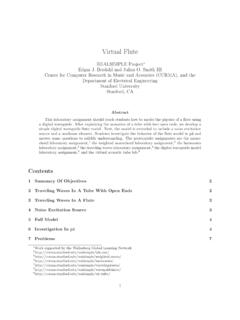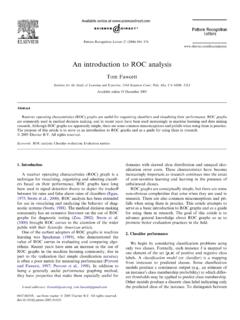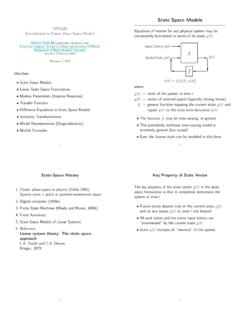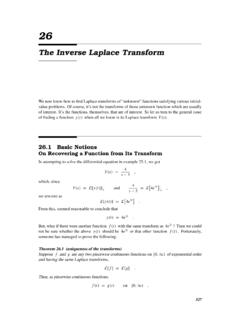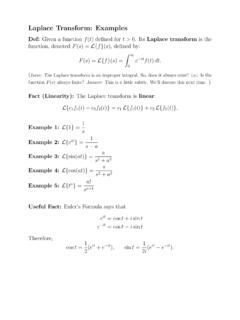Transcription of The Laplace Transform - CCRMA
1 Music 420: The Laplace TransformJulius O. Smith III for Computer Research in Music and Acoustics ( CCRMA )Department of Music, Stanford UniversityStanford, California 94305 February 5, 2019 Outline Definition Linearity and Differentiation Theorem Examples of Mass-Spring system analysis1 The Laplace TransformThe one-sided (unilateral) Laplace transformof a signalx(t)is defined asX(s) =Ls{x} = 0x(t)e stdt t=time in seconds s= +j is a complex variable Appropriate forcausalsignalsWhen evaluated along thej axis ( , = 0), theLaplace Transform reduces to the unilateralFouriertransform:X(j ) = 0x(t)e j tdtThus, the Laplace Transform generalizes the Fouriertransform from the real line (the frequency axis) to theentire complex Fourier Transform equals the Laplacetransform evaluated along thej axis in thecomplexsplaneThe Laplace Transform can also be seen as the Fouriertransform of anexponentially windowedcausal signalx(t)2 Relation to the z TransformThe Laplace Transform is used to analyzecontinuous-timesystems.
2 Its discrete-time counterpart is theztransform:Xd(z) = n=0xd(nT)z nIf we definez=esT, theztransform becomesproportional to the Laplace Transform of a sampledcontinuous-time signal:Xd(esT) = n=0xd(nT)e snTAs the sampling intervalTgoes to zero, we havelimT 0Xd(esT)T= lim t 0 n=0[xd(tn) t]e stn t= 0xd(t)e stdt =X(s)wheretn =nTand t =tn+1 tn= summary,theztransform (times the sampling intervalT)of a discrete time signalxd(nT)approaches, asT 0, the Laplace Transform of the underly-ing continuous-time signalxd(t).3 Note that thezplane andsplane are related byz=esTIn particular, the discrete-time frequency axis d ( /T, /T)and continuous-time frequency axis a ( , )are related byej dT=ej aTFor the mappingz=esTfrom thesplane to thezplaneto be invertible, it is necessary thatX(j a)be zero forall| a| /T. If this is true, we sayx(t)isbandlimitedbelow half the sampling rate. As is well known, thiscondition is necessary to preventaliasingwhen samplingthe continuous-time signalx(t)at the ratefs= 1/Ttoproducex(nT),n= 0,1,2.
3 4 Two Laplace Transform TheoremsLinearityThe Laplace Transform is alinear operator: x(t) + y(t) X(s) + Y(s)Proof:Letw(t) = x(t) + y(t),where and are real or complex constants. ThenW(s) =Ls{w} =Ls{ x(t) + y(t)} = 0[ x(t) + y(t)]e stdt= 0x(t)e stdt+ 0y(t)e stdt = X(s) + Y(s).Thus, linearity of the Laplace Transform followsimmediately from linearity of integration5 DifferentiationThedifferentiation theoremfor Laplace transforms: x(t) sX(s) x(0)where x(t) =ddtx(t), andx(t)is any differentiablefunction that approaches zero astgoes to notation:Ls{ x}=sX(s) x(0).Proof:Immediate from integration by parts:Ls{ x} = 0 x(t)e stdt=x(t)e st 0 0x(t)( s)e stdt=sX(s) x(0)sincex( ) = 0by assumptionCorollary:Integration Theorem:Ls{ t0x( )d }=X(s)s6 Laplace Analysis of Linear SystemsThe differentiation theorem convertsdifferential equationsintoalgebraicequations, which are easier to : Force-Driven MassConsider a free mass driven by an external force along anideal frictionless surface in one dimension:Physical diagram:f(t)v(t)mElectrical equivalent circuit:+-f(t)v(t)m7 Force-Driven Mass AnalysisNote that in the electrical equivalent circuit Driving force =voltage sourceemittingf(t)volts Mass =inductorofL= Newton s second law of motion f=ma , we havef(t) =m a(t) =m v(t) =m x(t).
4 Taking the unilateral Laplace Transform and applying thedifferentiation theorem twice yieldsF(s) =mLs{ x}=m[sLs{ x} x(0)]=m{s[s X(s) x(0)] x(0)}=m[s2X(s) s x(0) x(0)].Thus, given F(s) = Laplace Transform of the driving forcef(t), x(0) =initial mass position, and x(0) =v(0) =initial mass velocity,we can solve algebraically forX(s), the Laplacetransform of the mass position for allt 08 Force-Driven Mass Analysis, ContinuedIf the applied external forcef(t)is zero, we obtainX(s) =x(0)s+ x(0)s2=x(0)s+v(0) the Laplace Transform of the Heavisideunit-step functionu(t) ={0, t <01, t 0,we find that the position of the massx(t)is given for alltime byx(t) =x(0)u(t) +v(0)t u(t). A nonzero initial positionx(0) =x0and zero initialvelocityv(0) = 0results inx(t) =x0for allt 0(mass just sits there ) Similarly, any initial velocityv(0)is integrated withrespect to time (mass moves forever at initial velocity)In summary, we used the Laplace Transform to solve forthe motion of a simple physical system (an ideal mass) inresponse to initial conditions (no external driving forces).}
5 9 Mass-Spring Oscillator Time-Domain SolutionConsider now the mass-spring oscillator:mx= 0 x(t) x(t) kElectrical equivalent-circuit:1kmNewton s second law of motion:fm(t) =m x(t).Hooke s law for ideal springs:fk(t) =kx(t)Newton s third law of motion:fm(t) +fk(t) = 0 m x(t) +kx(t) = 0We have thus derived a second-order differential equationgoverning the motion of the mass and spring. (Note that10x(t)is both the position of the mass and compression ofthe spring at timet.)Taking the Laplace Transform of both sides of thisdifferential equation gives0 =Ls{m x+kx}=mLs{ x}+kLs{x}(linearity)=m[sLs{ x} x(0)] +kX(s)(differentiation theorem)=m{s[sX(s) x(0)] x(0)}+kX(s)(diff. thm again)=ms2X(s) msx(0) m x(0) +kX(s)Letx(0) =x0and x(0) = x0=v0for forX(s)givesX(s) =sx0+v0s2+km =rs+j 0+rs j 0, 0 = k/m,r=x02+jv02 0 =Rrej r,withRr = v20+ 02x202 0, r = tan 1(v0 0x0)denoting the modulus and angle of the pole residuer, Oscillator Analysis, ContinuedWe can quickly verify thate atu(t) 1s+awhereu(t)is the Heaviside unit step function which stepsfrom 0 to 1 at linearity, the solution for the motion of the mass isx(t) =re j 0t+rej 0t= 2re{re j 0t}= 2 Rrcos( 0t r)= v20+ 02x20 0cos[ 0t tan 1(v0 0x0)]If the initial velocity is zero (v0= 0), the above formulareduces tox(t) =x0cos( 0t)and the mass simplyoscillates sinusoidally at frequency 0= k/m, startingfrom its initial positionx0.
6 If instead the initial position isx0= 0, we obtainx(t) =v0 0sin( 0t) v(t) =v0cos( 0t).12
